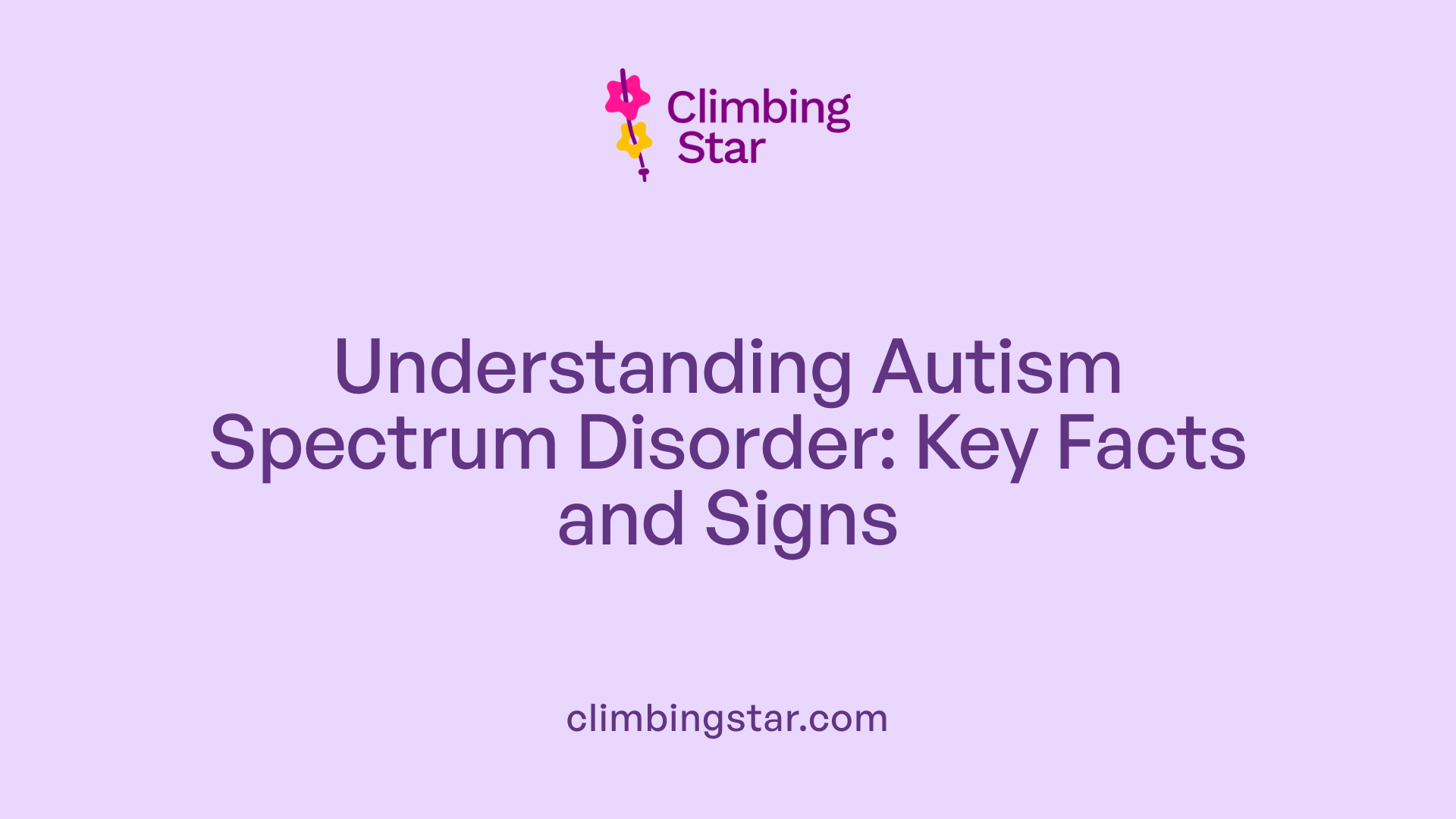Exploring Autism Spectrum Disorder and Its Treatments
Autism Spectrum Disorder (ASD) is a complex developmental condition characterized by challenges with social communication, restricted interests, and repetitive behaviors. As awareness of autism grows, so does the understanding of effective intervention strategies to support individuals on the spectrum. Among these, Applied Behavior Analysis (ABA) therapy stands out as a scientifically supported approach that helps improve communication, social skills, and daily functioning. This article delves into the nature of autism, the role of ABA therapy, the professionals who provide it, how progress is measured, and common misconceptions surrounding this treatment approach.
What Is Autism Spectrum Disorder?

Definition and Characteristics of ASD
Autism Spectrum Disorder (ASD) is a complex developmental condition characterized by persistent challenges in social communication and interaction, alongside restricted, repetitive behaviors and interests. Individuals with ASD experience these difficulties in varying degrees, which is why the term "spectrum" is used to describe the disorder.
Key Symptoms Including Social Communication Deficits and Restricted Behaviors
Social communication deficits in ASD can include reduced sharing of interests or emotions, difficulty understanding and using non-verbal cues like eye contact or gestures, and challenges in forming social bonds. Restricted behaviors often manifest as inflexibility in routines, intense focus on narrow interests, sensory sensitivities, and repetitive movements such as hand flapping. These symptoms impact everyday functioning and social participation.
Early Identification Signs and Diagnostic Process
Early signs of ASD might be observable before age one but become more apparent by age two or three. Signs include limited social smiling, poor eye contact, and delayed speech development. Diagnosis involves a thorough evaluation by specialists such as developmental pediatricians or child neurologists, who use interviews, behavioral observations, and sometimes standardized tests to assess the child’s behaviors and development.
Genetic and Environmental Risk Factors
Research indicates both genetic and environmental factors contribute to ASD risk. Various genetic syndromes like Fragile X and Tuberous Sclerosis are linked to autism. Environmental influences, including prenatal exposure to certain medications, can also increase risk. Because genetics are involved in over 30% of cases, genetic testing is recommended after diagnosis to provide additional insights and guide family planning.
Applied Behavior Analysis (ABA) Therapy: A Scientific Approach to Autism Intervention
What is Applied Behavior Analysis (ABA) therapy and how does it help individuals with autism?
Applied Behavior Analysis (ABA) therapy is a scientifically-supported method rooted in behavioral science and learning theory. It focuses on understanding how behavior works and how it is influenced by the environment. ABA helps individuals with autism by increasing beneficial behaviors like communication, social skills, attention, and academics while reducing harmful or problematic behaviors.
Foundations of ABA in behavioral science and learning theory
ABA is built on principles of operant conditioning, originally developed by Ole Ivar Lovaas in the 1970s. This approach emphasizes the role of learning from experiences to shape behavior. Behavior analysis examines the ABCs — Antecedents (what happens before a behavior), Behavior itself, and Consequences (what happens after). This framework allows therapists to identify triggers and outcomes that affect behavior, tailoring interventions for maximum effectiveness.
Core goals of ABA therapy such as increasing communication and social skills
The therapy aims to improve socially meaningful behaviors. Goals commonly include enhancing communication, social interaction, self-care, play, motor, and academic skills. For example, increasing expressive language helps individuals communicate needs, while social skills training supports better participation in daily life. Progress is monitored carefully with data collection, ensuring each step toward independence is measurable.
Common methods and techniques including positive reinforcement and Discrete Trial Training (DTT)
ABA uses various evidence-based techniques. Positive reinforcement, where desirable behaviors are rewarded, is central. Structured methods like Discrete Trial Training (DTT) break skills into small, manageable steps taught one-on-one, while naturalistic strategies such as Pivotal Response Treatment mimic play and serve as child-led learning. ABA also incorporates prompting, task analysis, and functional communication training to support learning.
Individualized treatment planning by certified professionals
Each ABA program is personalized to the individual's strengths, needs, and family preferences. A Board Certified Behavior Analyst (BCBA) conducts assessments and designs tailored treatment plans. Families often participate in training to carry strategies into daily routines, creating consistent support beyond therapy sessions. This individualized, collaborative approach has been shown to produce significant developmental improvements, especially when started early and provided intensively.
Goals, Methods, and Techniques in ABA Therapy

What are the typical goals and methods used in ABA therapy for autism?
ABA therapy is designed to increase useful skills and reduce behaviors that hinder learning and social interaction. Typical goals include improving communication, social skills, motor abilities, self-care, play, and academic performance. Each therapy plan is highly personalized, crafted by a Board Certified Behavior Analyst (BCBA) to meet individual needs and family preferences.
To achieve these goals, ABA breaks down complex skills into small, manageable steps. This systematic approach allows therapists to teach each component clearly while monitoring progress through data collection and frequent re-assessment.
Techniques Used in ABA Therapy
Positive reinforcement is a cornerstone technique, where rewards—like praise or tangible incentives—encourage desired behaviors. Other common strategies include prompting (providing cues to initiate a behavior), modeling (demonstrating the behavior), and task analysis (breaking tasks into smaller steps).
Functional communication training (FCT) is often used to teach children effective ways to communicate needs, limiting frustration and reducing challenging behaviors. The Picture Exchange Communication System (PECS) complements this by using pictures as a communication tool for nonverbal individuals.
Common ABA Treatment Methods
Discrete Trial Training (DTT): This method uses structured, one-on-one sessions with clear instruction, prompting, reinforcement, and repetition to teach specific skills.
Pivotal Response Treatment (PRT): A naturalistic, child-led approach focusing on pivotal areas like motivation and self-management, often delivered during play.
Early Start Denver Model (ESDM): Combines play-based activities with traditional ABA methods to target multiple developmental goals simultaneously in young children.
Together, these methods ensure therapy is engaging, effective, and aligned with each child's unique abilities and needs. Parents and caregivers are also trained to support skill development across everyday environments, enhancing generalization and long-term success.
Professionals Delivering ABA Therapy and Their Qualifications

Who provides ABA therapy and what qualifications do these professionals typically have?
ABA therapy is delivered by a team of specialized professionals who possess the necessary education, training, certifications, and licenses to provide effective behavioral interventions. The primary providers include:
Board Certified Behavior Analysts (BCBA): These are masters or doctoral-level professionals certified by the Behavior Analyst Certification Board (BACB). They conduct assessments, design individualized treatment plans, and oversee therapy implementation, often supervising others.
Board Certified Assistant Behavior Analysts (BCaBA): These professionals hold bachelor’s degrees and BACB certification at the assistant level. They implement behavior-analytic services under BCBA supervision.
Registered Behavior Technicians (RBT): RBTs have completed specific training and a competency assessment and provide direct behavior-analytic services under the supervision of a BCBA or BCaBA.
Licensed therapists: Some licensed speech therapists, occupational therapists, and psychologists with specialized training in behavior analysis also deliver ABA therapy.
Academic backgrounds and certification
Providers typically hold degrees in psychology, education, applied behavior analysis, or related fields. Certification by the BACB is the standard credential that ensures providers meet rigorous training, ethical, and competency criteria. For example, BCBAs have completed graduate-level coursework, supervised practical experience, and passed a certification exam. Many states also require licensure to legally practice, which involves background checks and adherence to professional codes of ethics.
Supervision and ethical standards
Certification mandates ongoing supervision, ethical practice, and continuing education. BCBAs supervise BCaBAs and RBTs, ensuring fidelity to treatment protocols and data-based decision-making.
Role in assessment and therapy
These professionals lead key components such as behavior assessments (often functional behavior assessments), development of targeted goals, selection of appropriate teaching methods, and progress monitoring. Their expertise allows treatment to be tailored to the unique skills and needs of each individual, involving families actively to help generalize skills across environments.
The combination of specialized education, certification, and oversight ensures ABA therapy is delivered effectively and ethically, maximizing its benefits for individuals with autism and other developmental disorders.
Measuring Progress and Effectiveness in ABA Therapy

Baseline Assessments and Data Collection Methods
ABA therapy begins with baseline assessments to understand current behavior levels before intervention. These assessments serve as a reference point to measure change. Data collection during therapy sessions is systematic and involves observing and recording specific targeted behaviors.
Tracking Behavior Frequency, Duration, and Intensity
Therapists measure how often (frequency), how long (duration), and how severe (intensity) behaviors occur. This quantitative tracking helps in identifying patterns and assessing whether interventions are effective in increasing positive behaviors or reducing harmful ones.
Use of Charts and Data Visualization for Progress Review
Collected data are visually represented using charts and graphs. These visual tools make it easier to monitor trends over time, enabling therapists and families to clearly see improvements or areas needing adjustment.
Regular Reports Shared with Families and Adjustments to Intervention
Families receive regular reports summarizing the child’s progress toward established goals. These reports foster collaboration between therapists and caregivers and guide any necessary changes to therapy plans to ensure continued effectiveness.
Research Evidence Supporting ABA Outcomes and Ongoing Evaluation Needs
Research consistently supports ABA therapy’s positive effects on social, communication, and behavioral outcomes. However, ongoing evaluation remains crucial, as current studies highlight the need for larger and longer-term investigations to fully understand ABA’s long-term impacts and optimize individualized treatment approaches.
Addressing Common Misconceptions About ABA Therapy

What are some common misconceptions about ABA therapy for autism?
Applied Behavior Analysis (ABA) therapy often faces misunderstandings regarding its approach and purpose. One major misconception is that ABA follows a one-size-fits-all method. In reality, ABA is highly individualized; each program is carefully designed by a qualified behavior analyst to suit the unique needs and goals of the individual.
Another widespread belief is that ABA relies on punishment to change behavior. Modern ABA therapy actually emphasizes positive reinforcement, using rewards to encourage helpful behaviors and make learning engaging and motivating rather than punitive.
Some people think ABA consists solely of rigid drills or repetitive tasks. However, ABA integrates play-based and naturalistic teaching methods, such as Pivotal Response Treatment and the Early Start Denver Model, which incorporate child-led interactions and real-life situations.
It is also important to clarify that ABA is not a cure for autism. Instead, it serves as skill development support aimed at improving communication, social skills, self-care, and independence to enhance the individual's overall quality of life.
Lastly, ABA therapy is backed by extensive scientific research and follows strict ethical standards. This ensures quality care and supports ABA as a credible, evidence-based treatment for autism spectrum disorder.
The Role of ABA Therapy in Supporting Individuals with Autism
Autism Spectrum Disorder is a multifaceted condition requiring tailored, evidence-based interventions to support individuals in reaching their full potential. Applied Behavior Analysis (ABA) therapy offers a well-researched, flexible, and personalized approach that has contributed significantly to improving communication, social skills, and adaptive behaviors in people with autism. Delivered by highly trained professionals, ABA therapy utilizes positive reinforcement and systematic methods to promote meaningful skill development. While it is not a cure, ABA helps individuals and their families enhance daily functioning and long-term independence. Awareness and understanding of ABA continue to grow, reinforcing its importance as a cornerstone in autism intervention and support.
References
- Applied Behavior Analysis (ABA)
- Applied Behavior Analysis (ABA)
- Applied Behavior Analysis in Children and Youth with Autism ...
- Treatment and Intervention for Autism Spectrum Disorder
- Applied Behavior Analysis (ABA) for Children With Autism
- What Is Autism Spectrum Disorder?
- Understanding ABA Therapy: A Comprehensive Overview
- Behavioral Treatment of Autism and Other Developmental ...
- Applied Behavior Analysis (ABA)
- How to Become an ABA Therapist - School of Education







